Winning the Turner prize was nothing, says Keith Tyson — he’s on a quest to find the meaning of life. Tony Barrell meets one of his favourite artists
THE SUNDAY TIMES, 2003
Here’s an art experiment to try. Walk down a street in Britain – preferably a crowded street – and politely stop some of the passers-by and ask: “Have you heard of Keith Tyson?” I predict a low hit rate. If, after stopping perhaps hundreds of men, women and children, you finally get a “Yes,” ask a second question. “Who is he?” Don’t be surprised if the conversation then turns to boxing, bitten-off ears, rape and prison.
Keith Tyson is not a boxer. Well, not a professional one, anyway. He is the 2002 winner of Britain’s best-known, most argued-about prize for art, an award that has brought fame and fortune to several of its winners. And at least one of the losers of that trophy, the Turner prize – try “Who’s Tracey Emin?” in that same street – has become a household name.
This is strange. In November 2002, the public message board at Tate Britain’s Turner-prize exhibition gave the strong impression that Tyson was “the people’s choice” for the prize. And he tells me that after he took the £20,000 award away, he was “overexposed” in newspapers and magazines across the world. “Imagine doing three months of interviews,” he says.
Tyson has been dubbed the “mad professor” of art, owing to his obsessions with physics, philosophy, probability, computers, astronomy, science fiction and experimentation. He could equally be labelled “the Anti-Hirst”, being as passionate about the miracle of life as the famous Damien seems to be about the inevitability of death.
Tyson took every item on the KFC menu and cast it in lead
Much of Tyson’s art is just as controversial and memorable as any unmade bed: there’s The Thinker (After Rodin), his tall black column that hums with mysterious electronic life, which we’re told contains computer equipment programmed to cogitate for thousands of years. There’s his representation of the entire Colonel Sanders repertoire – every single item on the KFC menu, cast in lead. And there are his copious studio wall drawings – wild, intricate meditations on everything from the evolution of galaxies to what happens when you shuffle a pack of playing cards, all of it bursting with colour as if Einstein has run off with Gauguin’s paintbox.
It may be that the artist’s non-household-namehood is the result of Keith Tyson getting his own way. “I want my work to be famous, but I’m perfectly happy to be inconspicuous,” he confides in his soft Cumbrian accent when we meet at his studio in Bermondsey, southeast London. He dresses the part of the anonymous experimental artist perfectly, his shirt flapping outside his jeans, long curly brown hair framing a bearded face, a hippyish wooden-bead necklace round his neck. He is sweating, having just enjoyed one of his regular morning kick-boxing sessions with his trainer – “just to get fit, really”. A big, gentle bear of a man, 34-year-old Tyson even views his own bulk in astronomical terms: “I’m 18½ stone – I own more of the universe than most people.”
He can also talk more than most. Over the next three hours he will hold forth on the history of art, the fascination of science, the drudgery of making nuclear submarines and the joy of playing roulette. The transcript of his words will set a 20-year interview record for me, reaching 38 A4 pages of closely written text. “I don’t have many people come and visit me, so when they do they get the full windbag,” he apologises.
On the walls around him are huge, chaotic canvases and other works in progress, one of which takes the form of two large interlocking white circles: the basis for what could be his most ambitious project yet. “This is called The Teleological Accelerator,” he explains, “in which I’m trying to take all fields of human activity on a huge disc and breed them with each other freely to make raison d’êtres to produce other works.”
All fields of human activity? How is that possible?
“It starts in the centre, and you have art and science and philosophy and all their different aspects, and those get split into other things – we divide up the sciences – and we split them up again and again. And right on the periphery you have basically everything that’s going on, whatever is at the cutting edge. It’s all in tiny, tiny writing.”
The disc – which is more of a system for generating art than a work in itself – embodies a complex system of viewfinders that allows you to select a random combination of these written elements. For example, he has already originated an art work combining homoeopathy, pollution and the sculpture of a flower. When these factors are processed by the prodigious Tyson mind, they come out as “a metal flower, in a park, letting out noxious gas in tiny quantities”.
Another product of the Accelerator is a proposal for an underwater pier in Hawaii, with lights corresponding to hormonal changes over the course of women’s lives. He passionately believes that this art-generation mechanism will accelerate the process by which he learns about the world – “the argument being that the world is ready for certain emergent ideas, and this thing will get me there quicker than if I was trying to work them out myself”.
I think I’m a very traditional artist: I’m depicting the world I see around me. I’m trying to form a jigsaw puzzle of reality
The Teleological Accelerator, which became the centre of a 2003 exhibition in Berlin, embodies both his near-religious belief in the value of chance (”My interest is to just try and stumble upon something that’s interesting; I believe that if you’re open to opportunity and serendipity, they reward the work”) and his determination to represent the complexity of life. “I just think we live in a very complicated world,” he says. “I think I’m a very traditional artist in that way: I’m actually depicting the world I see around me. I’m trying to form a jigsaw puzzle of reality.”
His preoccupation with science gives critics a new take on the usual philistine gallery groan – “But is it science?” “By no means am I a scientist,” he replies, “and neither am I illustrating science. Often I’m asked, ‘Do you want to go on with this panel of scientists and talk?’ But we’re operating in different fields. Yes, I’m influenced by science, but then people are influenced by all sorts of things; they’re influenced by dance music, but they’re not expected to go on a forum on dance music.”
Art-production mechanisms like the Accelerator – making something that will go on to generate its own works of art – are definitely a Tyson theme. When I visit his studio, he is immersed in a series of paintings called The Primordial Soup with Homeopathic Dilutions. For this, he is “loading up” a 10ft-square canvas with representations and verbal descriptions of a welter of concepts – from Tube stations to “manufactured pop bands”, from “the anti-globalisation movement” to “perpetual motion” and “colonisation by planet-hopping”. Then he “zooms in” and takes a closer look at small sections of this beautiful “soup”, and produces smaller paintings based on the content of those sections. “So you start off with an absolute lack of focus, and work towards more specificity. The smaller pictures I want to be finished pictures, the kind you’d hang in a gallery as if your whole life depended on them – but they’ve all been born from this primordial soup.”
Back in the 1990s, long before the Primordial Soup and The Teleological Accelerator, there was the Artmachine. Other writers have described this Tyson creation as a computer program that randomly searched the internet and put together chance combinations of words, but Tyson reveals that it was much more Heath Robinson than that.
“Most of it was on paper,” he says – “in the form of flowcharts and books – though it did incorporate a Macintosh computer and some electronic random-number generators.” The Artmachine told him to build a delightful, tall drum kit that reached up into a tree, for accompanying the twittering of the dawn chorus. It ordered him to paint a hangman’s noose using toothpaste and some of the latest music CDs. And it was coincidental that most of these CDs had all these boy-band guys with these cheesy grins. It looked as if it was a comment on the fake smile or something, but of course it wasn’t. “But the brain’s an amazing pattern-recognition device.”
The Artmachine years were “a huge learning curve” for him, “because it would ask me to do things I have no skills in”. So it was a kind of art teacher? “Totally. I was such an anal artist before I used the Artmachine: all my work was like little flowcharts, maps and stuff. Now it’s all grandiose stuff. And, in many ways, I programmed the machine and it programmed me. I would go to art exhibitions and think, ‘Could it come up with that?’ And if it couldn’t, I would program another bit on the end of it that could. So it grew and grew.”
Around the turn of the century he stopped using the Artmachine. “I just felt like the hurdy-gurdy man, turning the handle. And it was only ever one of the many interesting ways of producing work that I was involved with.” He also couldn’t keep up: “I think I’ve got something stupid like 12,000 Artmachine proposals that I’ve never made. In those days, I didn’t have the money. Some of them were colossal steel structures.”
The Artmachine is now under wraps somewhere – possibly in a room at his home in Brighton, though he is oddly secretive about it. “I never showed the Artmachine. At some point I will, but at the moment it’s staying there.” It seems his love of puzzles and mysteries extends to the act of creating them himself. Listen to him talk about his sculpture The Thinker: “The computers inside don’t have any peripherals, so you can’t see what it’s thinking. You know it is, or I claim it is and it doesn’t matter if it is or it isn’t. It sort of is, because it appears to be. Or does it?”
He went to a London railway station, bought all the newspapers there, and made a column out of them, which he called Monument to the Present State of Things
Tyson is a British conceptual artist, so there is mischief as well as mystery in his work. In 2000, he and some assistants went to a London railway station – he refuses to tell me which one – and bought all the newspapers within a 500-metre radius before the rush hour. “Then I made this column out of the newspapers, and it’s called Monument to the Present State of Things.” Here, the art work isn’t really the paper monument, says Tyson: it’s that people are forced to either look out of the train window or talk to the person opposite, “or just live a slightly different life to the life they would’ve lived if they’d had the newspapers”. He even suggests that this art stunt helped to make babies: “There are people that exist that wouldn’t have existed without the sculpture being made.”
Tyson himself was born Keith Thomas Bower in Ulverston, Cumbria, on August 23, 1969, and grew into a dreamy boy who passed the time programming a primitive home computer, watching sci-fi films, reading the Encyclopaedia Britannica and having nightmares. There is surely a pointer to his future career in the baffling nature of one of his most terrifying recurring dreams, and in the fact that, around the age of eight, he gave it a title: The Theatre of Horses.
“It was like a messianic Jesus dream, really,” he says. “I’d be walking along and I’d enter this big amphitheatre, and there was just a pole in the middle. I would get strapped to it, and these people would cut my throat and say, ‘By you dying in the dream, your dream becomes autonomous and we can all live a separate life.’ And I would wake up, but I hadn’t really woke up, and I would have to go through it again and again and bring all these worlds into existence. It used to freak me out.” What about the horses? “Oh, there’s no horses in it. I just know it was called The Theatre of Horses – I don’t know why.”
In the real world, Tyson left school at 15 without any qualifications and found himself making Trident nuclear submarines as an apprentice engineer at the shipyard in Barrow-in-Furness, after his stepfather – who gave him his new surname – demanded that he pay rent to live at home. “I didn’t fit in at the shipyard at all. I used to draw little cartoons of the people in there – I would survive that way.” Also, in that systematic way he still has, the teenager dubbed Psycho by his workmates started completing a painting every day. These daubs were “dreadful”, he says now, and he had no idea that they would become his passport out of the shipyard. “I didn’t know you could be an artist for a living. I thought painting had finished in the 19th century, and if you were an artist you had to design cornflakes packets.”
But in 1989, unable to face the daily grind any more, he took his strange oeuvre to Carlisle College of Art and was accepted for an art foundation course. A year later, liking the look of an experimental art course at Brighton University, he travelled south with a head full of ideas and an overdraft.
I’ve got a big gambling problem. Just before the Turner prize, I packed it in. Fruit machines and horse-racing were both obsessions
He calls this decision “a gamble”, and now we’re in classic Tyson territory. It’s logical that this artist, whose work repeatedly reveals a passion for chance and mathematical patterns, should enjoy a flutter or two. “I’ve got a big gambling problem,” he admits. “Just before the Turner prize, I packed it in.”
“Fruit machines and horse-racing were both obsessions”, he says, but his favourite by far was roulette. “It’s the full Dostoevsky – it’s your life in a spin. Once you get in the flow of that, it’s almost like a religious experience.”
While he may dress up his addiction as an intellectual devotion to probability, he is fully aware of the seedy truth. “It’s like somebody saying, ‘Oh, I’m studying pornography for an intellectual reason,’ but in fact they’re really getting off on it. It’s the same with gambling, with me. Recently I was asked to be on Celebrity Poker Club or something on TV, and I was desperate to do it, but I just knew it was wrong: it would just excite me again.”
But the Brighton gamble paid off in spades: not only did he blossom as an artist, but he met his future wife. In the tradition of John and Cynthia Lennon and Rolf and Alwen Harris, Tyson fell in love with and married a fellow art student. Touchingly, he says that just being with Xenia, from Germany, has cured him of his most terrifying dreams. She is a video artist – “a very talented artist, though she’s actually a full-time mum at the moment, and very happy with that”.
Tyson, who commutes by train between the Brighton marital home and his London studio, reveals himself as an indulgent, free-and-easy father to their two young sons, Curtis and Elvis: “This morning, Curtis woke up and was screaming and wanted to dance in the front room, so I had to go down and do all that.” It’s refreshing to hear Tyson talk about simple domestic stuff – as when he wished his gran a happy birthday in his Turner acceptance speech – but he doesn’t do it for long before he is discussing the importance of art or the meaning of life again, as if every corner of his being has been aestheticised.
Even when he makes a case for being a rounded, multifaceted human being, he slips into a rant against minimalism: “When I go home and watch the television, I’m not a sophisticated artist: I’m just a viewer like everybody else. And when I’m with my wife and kids I’m a different person, and when I’m reading a philosophical book then I’m a different person. But those states are all one identity. The idea that you have to simplify yourself down and say, ‘This is me,’ and produce this one identity, is a nonsensical and particularly modernist idea that I don’t really hold to. It’s a legacy of reductionism, this idea that if you understand the simplest elements of something you’re going to understand the whole, and I just don’t agree with that.”
The Turner prize is a bit of a lottery. In a different year with different artists, someone else would’ve won. There’s a lot of chance involved
This summer he took his family on holiday in Cornwall, and had fun attempting to surf. “I actually, for once in my life, turned off a bit,” he says, “and I don’t think I’ve done that in 11 years or something.” The words “a bit” are important here, because Tyson goes on to reveal: “I remember watching the waves and trying to calculate how they worked. I did that for hours…”
When he talks about the Turner prize, he returns to the language of gambling. “I still, to this day, don’t know what made me, or anybody else, a Turner-prize winner. It’s a bit of a lottery, and that’s no exaggeration. If you’d been in a different year with different artists, someone else would’ve won. There’s a lot of chance involved.”
Has the Turner changed anything for him? “I think before the event, you think it’s probably a big deal, like getting your exam results. But the second you’ve got it, you realise it doesn’t mean anything at all, really. It does in terms of the way people collect your work and think about your significance, but ultimately as an artist all you’re concerned about is the scene of the crime in the studio. It doesn’t matter a jot, because I don’t think I’m doing any different work than I would’ve been doing – other than perhaps I may be financially a bit more sound, so I can do more ambitious work.”
Asked if he is now a millionaire, he gives one of his more opaque answers. “Well, it depends how you count it. If you strip away all your assets and cash your chips in, I’m sure I am. But I don’t feel like that – I don’t have any money in the bank.” Unless he is gambling his funds away, this seems an underestimate – he has keen collectors across the world, and his prices compare favourably with those of the better-known Brit artists: his wall drawings go for £10,000 each, and The Teleological Accelerator would set you back £75,000.
Money-spinning new commissions include two huge painted panels, both about 40ft by 10ft, for the foyer of the skyscraping new Hyatt Center in Chicago. “My idea was to sort of build a kind of molecule virtually, inside the building. It’s implying the interconnectedness of these spheres of influence in this building, which is going to have huge economic superpowers working in it.”
The molecule panels – redolent of his eye-catching work Bubble Chambers: 2 Discrete Molecules of Simultaneity, seen in last year’s Turner-prize show – also reflect his interest in scales of life. “There’s a scale at which a certain level of complexity can be played out. If you look at tiny, tiny places, time runs very, very quickly: things come into being and are gone in nanoseconds. And at the scale of the Milky Way, the time to get a single bit of information from one galaxy to another would be so vast, it’s impossible to generate complexity. I believe the scale of life is the scale sandwiched between these two scales. Do you see what I mean?”
Critics seem polarised over Tyson. He hates it when they call his work clever-clever – as when The Independent said his output was “more the tricksy, adroit antics of some brainbox than art of any memorable substance”. He also hates his art being dismissed as silly, as when that distinguished critic Vanessa Feltz damned him in the Daily Express as “infantile” and “clodhoppingly unsubtle”.
“Often they think I’m some kind of charlatan,” he says, “playing chess games with the art world. It’s simply not true. Why would I, as an intelligent person, spend my life pulling the wool over a few people’s eyes? I could go to the stock market and earn a fortune – I’ve got a good brain. But I love art, and I want to contribute to it and make sure that there’s something good out there. The negative things that I’ve read about my work – it’s little boys’ childish art, it’s small-minded – I think, well, that may be true, but if you can go outside and look up at the stars and say, ‘Oh, that’s boring,’ then fine, I’m not making work for you!
“I don’t want to look like the cleverest boy in the class, and I wouldn’t put up all my crappy bits and workings-out if I did.” Though he ultimately exhibits his studio wall drawings as works of art in themselves, “a lot of them are just reminders to myself of some fundamental principles – because otherwise you get sidetracked, and I’m easily sidetracked! They form a kind of journal, like Van Gogh’s letters or something, but they’re a much more loose jazz approach to keeping a record of what you’re thinking about”.
Tyson’s wide-eyed enthusiasm for the universe we live in is infectious. But where are the limits of that enthusiasm – what bores him? He leaves the longest pause of the interview, genuinely stumped to think of something he can’t get excited about. “Erm… I don’t know,” he says, and launches by way of proof into a paean to management consulting and self-help books. “I’m fascinated with all of that positive thinking, and the way they try to form religions out of it in a secular society. Nothing bores me. I find time management fascinating. Accountancy: fascinating!”
Tyson has spent much of his career challenging the traditional godlike role of the artist, letting chance take over and ‘giving up the ego’, as he puts it
There are probably three reasons why those people in the crowded street don’t know who Keith Tyson is. First, prolific maximalists with an all-encompassing love of life’s complexity are impossible for our minimalist tabloids to sum up satisfactorily. Second, Tyson is not a party animal, not the kind of gadabout who gets photographed at trendy art functions, like Tracey Emin or Sam Taylor-Wood. And third, with his Teleological Accelerator and his Primordial Soup and his Artmachine, he has spent much of his career challenging the traditional godlike role of the artist – letting chance take over and “giving up the ego”, as he puts it at one stage.
On Hallowe’en in 2003, Tyson was due to appear at Tate Britain in London to discuss the Turner prize with Janet Street-Porter and other art pundits. Disappointingly, he didn’t appear, sending the message that he had “done his back in”. The invisible artist strikes again. ♦
© 2015 Tony Barrell
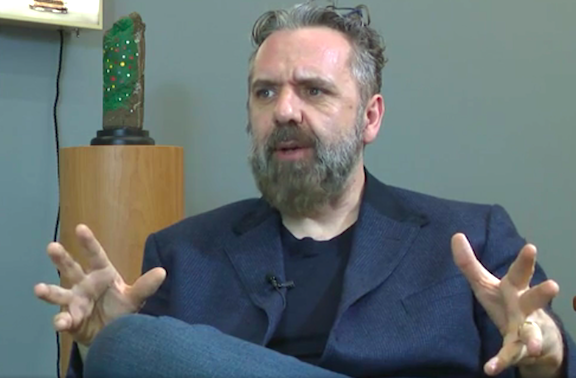
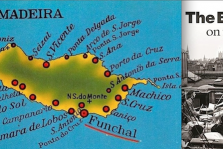
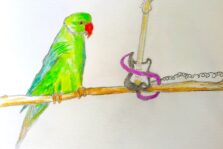
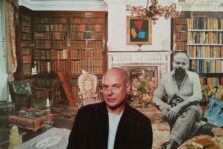
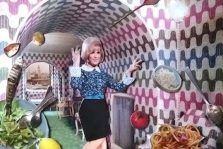
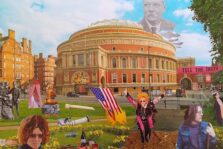
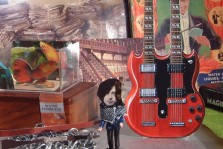

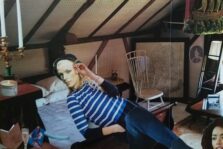
Great piece. Tyson is such an underrated artist.